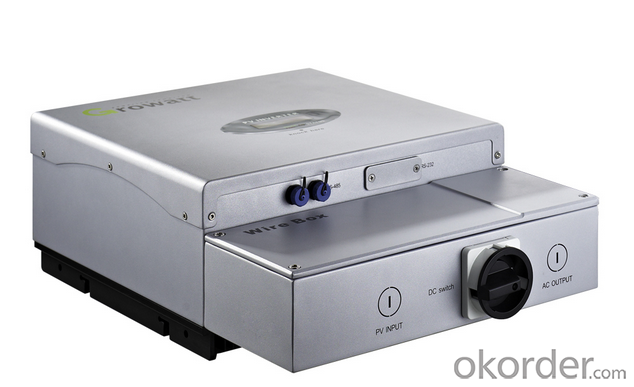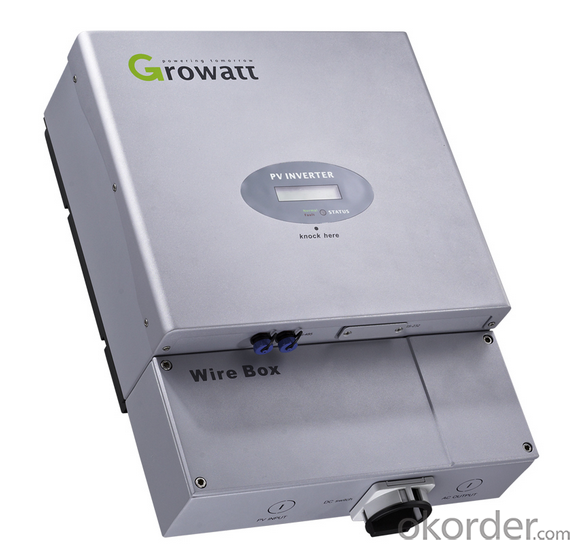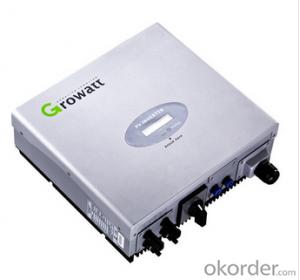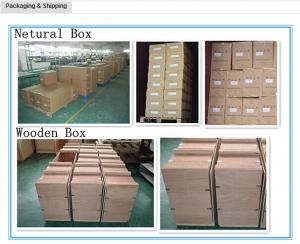Grid Connected Solar Inverter 4000W-5000W Solar System
- Loading Port:
- Shekou
- Payment Terms:
- TT or LC
- Min Order Qty:
- 10 pc
- Supply Capability:
- 10000 pc/month
OKorder Service Pledge
OKorder Financial Service
You Might Also Like
Grid Connected Solar inverter 4000W-5000W
Maximum efficiency of 97.8% and wide input voltage range
Internal DC Switch
Transformerless GT topology
Compact design
MTL-String
Bluetooth/ RF technology/ Zigbee/ Wi-Fi
Sound control
Easy installation
Comprehensive Growatt warranty program
Maximum efficiency of 97.8%
wide input voltage range
Internal DC Switch
Transformerless GT topology


Communications
> RS485 /GPRS interfaces
> Computer monitoring software
Safety
> Full protection functions:DC reverse polarity, AC short-circuit protection, ground fault monitoring, grid monitoring, integrate all-pole sensitive, leakage current monitoring unit.
> Standards complied: EN61000-6-1, EN61000-6-2, EN61000-6-3, EN61000-6-4,EN61000-3-2, EN50178, VDE0126-1-1,IEC-62109
Technical Specifications
4000TL | 4400TL | 5000TL | |
| Inputdata | |||
| Max.DCpower | 4600W | 5000W | 5800W |
| Max. DC voltage | 580V | 580V | 580V |
| StartVoltage | 120V | 120V | 120V |
| PV voltage range | 90V-580V | 90V-580V | 90V-580V |
| MPP voltage range/ Nominal voltage | 95V-580V/360V | 95V-580V/360V | 95V-580V/360V |
| Full load DC voltage range | 250V-500V | 250V-500V | 250V-500V |
| Max. input current/ per string | 20A/20A | 20A/20A | 20A/20A |
| Number of independent MPP trackers /strings per MPP tracker | 1/3 | 1/3 | 1/3 |
| Efficiency | |||
Max.efficiency | 97.8% | 97.8% | 97.8% |
| Rated AC output power | 3680W | 4200W | 4600W |
| Max. AC power | 4000W | 4400W | 5000W |
| Max. output current | 16A | 21A | 25A |
| AC nominal voltage; range | 220V/230V/240V 180Vac-280Vac | 220V/230V/240V 180Vac-280Vac | 220V/230V/240V 180Vac-280Vac |
| AC grid frequency; range | 50Hz, 60Hz;±5Hz | 50Hz, 60Hz;±5Hz | 50Hz, 60Hz;±5Hz |
| Power factor | 1 | 1 | 1 |
| THDI | <3% | <3% | <3% |
| AC connection | Single phase | Single phase | Single phase |
| Protection Devices | |||
| DC reverse polarity protection | yes | yes | yes |
| DC switch rating for each MPPT | yes | yes | yes |
| Output over current protection | yes | yes | yes |
| Output over voltage protection-varistor | yes | yes | yes |
| Ground fault monitoring | yes | yes | yes |
| Grid monitoring | yes | yes | yes |
| Integrated all-pole sensitive leakage current monitoring unit | yes | yes | yes |
| Generaldata | |||
Dimensions(W/H/D) in mm | 406/406/192 100% | 406/406/192 21KG | 406/406/192 |
| Features | |||
DC connection AC connection Display Warranty: 5years/10years | H4/MC4(opt) Screw terminal LCD yes/opt | H4/MC4(opt) Screw terminal LCD yes / yes / yes/opt | H4/MC4(opt) Screw terminal LCD yes / yes / yes/opt |
| Certificates and ApprovalsCE, VDE 0126-1-1, DK5940, G83, G59, RD1663, EN50438, IEC 62109, ENEL-Guide |
- Q:What is the role of a power management system in a solar inverter?
- The role of a power management system in a solar inverter is to efficiently manage the flow of electricity from the solar panels to the grid or the connected devices. It ensures that the power generated by the solar panels is optimized, regulated, and synchronized with the grid's requirements. The power management system helps in maintaining the stability and reliability of the solar inverter system by monitoring, controlling, and adjusting the power flow, voltage levels, and frequency to prevent overloading or underutilization of the solar energy.
- Q:Can a solar inverter be used with a remote control system?
- Yes, a solar inverter can be used with a remote control system. Many modern solar inverters are equipped with built-in communication capabilities, such as Wi-Fi or Bluetooth, which allow them to be connected to a remote control system. This enables users to monitor and control the inverter's performance, settings, and parameters remotely, providing convenience and flexibility in managing their solar power systems.
- Q:How do you connect solar panels to a solar inverter?
- To connect solar panels to a solar inverter, you need to follow a few steps. First, ensure that the solar panels are properly installed and positioned to receive maximum sunlight. Then, connect the positive and negative terminals of each solar panel in series or parallel, depending on the system design. Next, connect the positive and negative terminals of the solar panel array to the input terminals of the solar inverter. Finally, double-check all connections and wiring to ensure they are secure and tight.
- Q:How does a solar inverter handle voltage and frequency variations caused by load shedding?
- A solar inverter handles voltage and frequency variations caused by load shedding by constantly monitoring the grid conditions. When it detects a drop in voltage or frequency, it adjusts its output parameters accordingly to maintain a stable supply of electricity to the connected loads. This ensures that the devices receiving power from the solar inverter are not affected by the fluctuations in the grid caused by load shedding.
- Q:Can a solar inverter be used with different types of solar cell technologies?
- Yes, a solar inverter can be used with different types of solar cell technologies. Solar inverters are designed to convert the DC electricity generated by solar panels, regardless of the type of solar cell technology, into AC electricity that can be used to power homes and businesses. Therefore, whether it is monocrystalline, polycrystalline, thin-film, or any other solar cell technology, a solar inverter can efficiently convert the generated electricity into usable form.
- Q:How does a solar inverter handle harmonics in the grid?
- A solar inverter handles harmonics in the grid by incorporating a built-in filter that helps mitigate the impact of harmonics. This filter is designed to reduce the distortion caused by harmonics, ensuring that the inverter's output adheres to the required grid standards. Additionally, advanced inverters may also employ control algorithms that actively monitor and adjust the output waveform to minimize harmonic distortion and maintain grid stability.
- Q:What is the role of a reactive power controller in a solar inverter?
- The role of a reactive power controller in a solar inverter is to regulate and maintain the flow of reactive power to ensure a balanced and stable electrical grid. By dynamically controlling the reactive power output, the controller helps to improve power factor, minimize voltage fluctuations, and enhance the overall system performance and efficiency of the solar inverter.
- Q:Can a solar inverter be used with different types of solar panels (monocrystalline, polycrystalline, thin-film)?
- Yes, a solar inverter can be used with different types of solar panels such as monocrystalline, polycrystalline, and thin-film. Solar inverters are designed to convert the direct current (DC) produced by solar panels into alternating current (AC) suitable for use in household or commercial electrical systems. As long as the solar panels generate DC power within the operating range of the inverter, they can be compatible regardless of the technology used.
- Q:What is the role of a galvanic isolation circuit in a solar inverter?
- The role of a galvanic isolation circuit in a solar inverter is to provide electrical safety by preventing the flow of direct current (DC) between the solar panels and the alternating current (AC) grid. It isolates the input and output sides of the inverter, protecting the user and the equipment from potential hazards such as electrical shocks and short circuits. Additionally, it helps in reducing noise and improving the overall performance and efficiency of the solar inverter system.
- Q:PV grid-connected inverter and independent inverter in the control of what is the difference
- Photovoltaic grid-connected inverter is the assembly of the DC into AC power for the use of load, or do not use the load, the inverter after the AC power to the city power grid, when the electricity outage, the inverter will automatically
1. Manufacturer Overview |
|
|---|---|
| Location | |
| Year Established | |
| Annual Output Value | |
| Main Markets | |
| Company Certifications | |
2. Manufacturer Certificates |
|
|---|---|
| a) Certification Name | |
| Range | |
| Reference | |
| Validity Period | |
3. Manufacturer Capability |
|
|---|---|
| a)Trade Capacity | |
| Nearest Port | |
| Export Percentage | |
| No.of Employees in Trade Department | |
| Language Spoken: | |
| b)Factory Information | |
| Factory Size: | |
| No. of Production Lines | |
| Contract Manufacturing | |
| Product Price Range | |
Send your message to us
Grid Connected Solar Inverter 4000W-5000W Solar System
- Loading Port:
- Shekou
- Payment Terms:
- TT or LC
- Min Order Qty:
- 10 pc
- Supply Capability:
- 10000 pc/month
OKorder Service Pledge
OKorder Financial Service
Similar products
New products
Hot products
Hot Searches
Related keywords

































